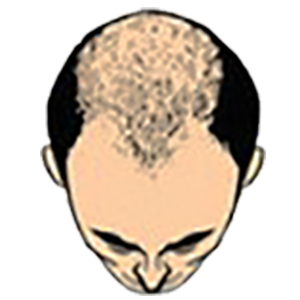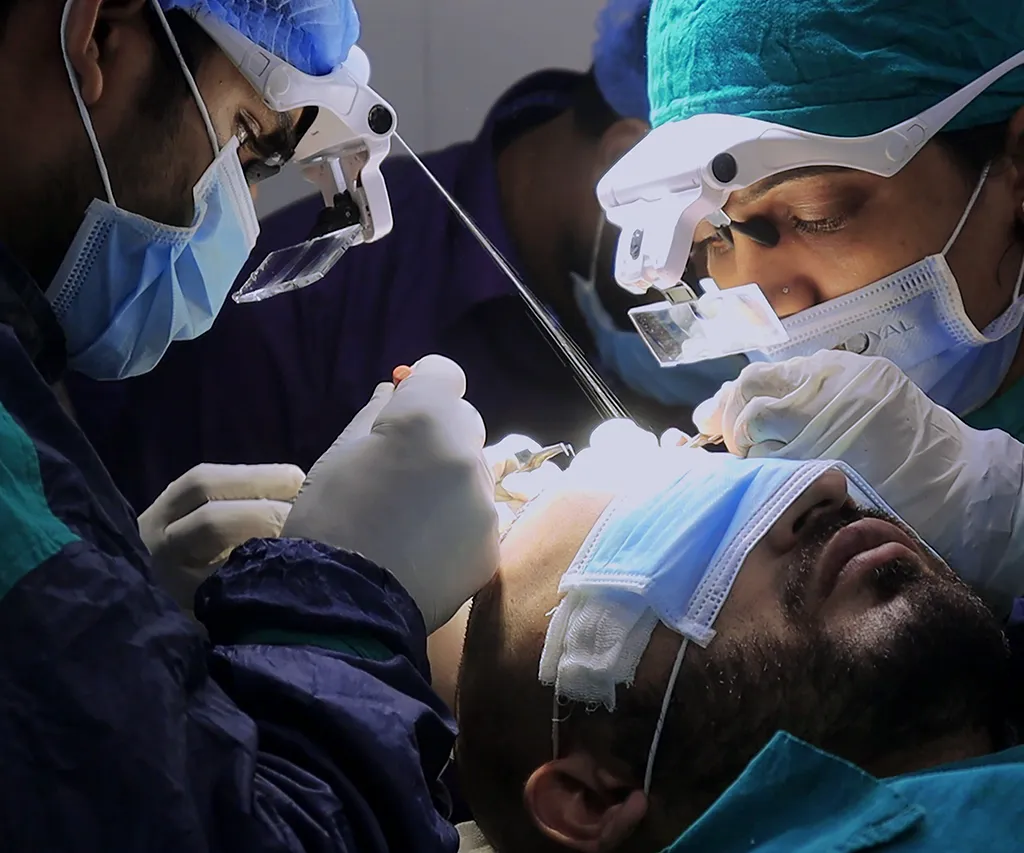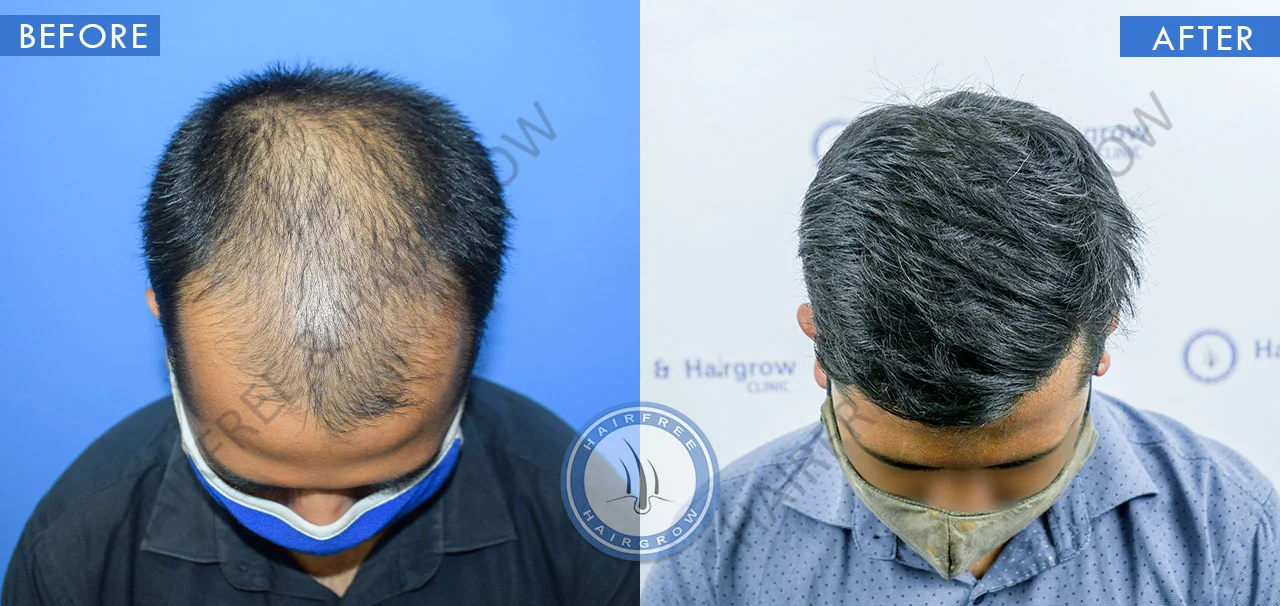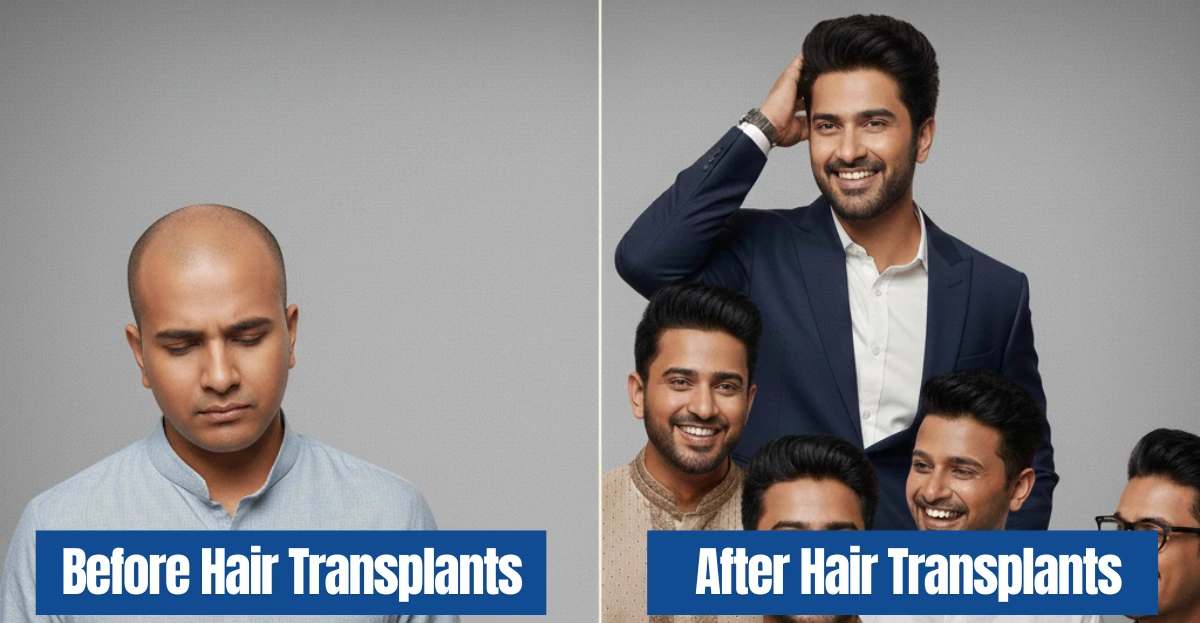Male Hair Transplant Bangladesh
Hair transplant surgery is a cosmetic procedure for people who suffer from hair loss and wish to restore hair growth in areas where it has become thin or completely bald. This non-elective surgery involves relocating hair follicles from a donor site on the body to the recipient site or bald area.
Male pattern baldness usually begins with a receding hairline and thinning at the crown and gradually leads to complete hair loss on the top and crown areas of the head.

Causes of Hair Loss in Men
Below are some factors that can contribute to hair loss
Grades of Male Pattern Baldness
Norwood-Hamilton scale
“Male Pattern Baldness” is a condition that can be classified into different grades based on the extent and location of hair loss. These grades help doctors determine the appropriate treatment plan for a patient.
There are 7 grades of male pattern baldness, ranging from minimal hair loss with a slightly receding hairline (Grade I) to extensive hair loss leaving only a horseshoe-shaped band of hair around the sides and back, with hair loss in the top, middle, and wide areas of the crown (Grade VII). These grades help individuals and hair transplant specialists determine the most suitable treatment for each individual.
Prevalence of Male Pattern Baldness vs Female Pattern Baldness
Male pattern baldness is more common than female pattern baldness, affecting about 50% of men at the age of 25-30 Years. Whereas female pattern baldness occurs in about 30% of women over 50.

Minimal hair loss with a slightly receding hairline

Mild hair loss with a more noticeable recession of the hairline

Further recession of the hairline and increased balding to the middle area of the top of the head

Significant hair loss with a distinct balding pattern extending to the crown.

Advanced hair loss, with thinning in crown.

Severe hair loss, limited hair remaining on the sides and back.

Extensive hair loss, typically leaving only a horseshoe-shaped band of hair around the sides and back. Top, middle, and wide areas of the crown with hair loss.

The Role of Hair Transplants in Male Pattern Baldness is the final and permanent solution.
Baldness with Grades 3 and above requires a hair transplant, which is the best solution nowadays.
Hair transplantation
There are Two Types of hair Transplant Methods
1. Follicular unit transplant (FUT)
FUT is an outdated technique that involves extracting a strip of hair-bearing scalp from the donor area and dissecting it into individual follicular units for transplantation.
2. Follicular unit extraction (FUE)
FUE is the newest and most advanced hair transplant technique that involves extracting individual hair follicles directly from the donor area and transplanting them to the recipient site.
The Hair Transplant Procedure Typically Follows a Few Key Steps
1. Consultation
The hair transplant procedure involves several key steps, including a consultation with a hair transplant specialist to evaluate the extent of hair loss, assess the quality of donor area hair, discuss expectations, and provide personalized recommendations.
2. Donor Site Selection
The donor site for a hair transplant is typically located on the back or sides of the scalp, where the hair is genetically resistant to balding caused by DHT. These areas have healthy hair follicles that can be transplanted. Another donor site is the beard. If the hair on the back of the scalp donor site is insufficient, hair follicles from below the jawline bone area can be extracted for transplant from the beard while maintaining its shape. Donor area selection is crucial for the results after hair transplant surgery. While hair from other areas such as chest, armpits, genital area, or legs can be used as donor sites, it is not recommended as the hair from these areas is typically weak and may not provide satisfactory results.
“How to Harvest Donor Hair” can be a topic of interest for those who are considering hair transplantation.
There are two primary techniques for harvesting donor hair follicles:
Follicular Unit Transplantation (FUT)
Follicular Unit Transplantation (FUT) is an outdated technique that most doctors avoid nowadays due to the risks involved. This procedure involves surgically removing a strip of scalp tissue containing hair follicles from the donor area, which is then dissected into individual units for transplantation. However, this technique often results in a large scar on the scalp and can cause complications. As a result, other advanced hair transplant techniques are preferred over FUT in contemporary hair transplant surgery.
Follicular Unit Extraction (FUE).
FUE: The FUE technique is the most advanced hair transplant method for harvesting donor hair in the world. It involves the extraction of individual hair follicles directly from the donor area using a specialized serrated punch-like instrument. This technique leaves small, dot-like scars that are less visible compared to the linear scar left by FUT. FUE is the most efficient and successful method for obtaining donor hair follicles. It is widely recognized and accepted due to its ability to harvest the maximum number of hair follicles without causing any damage, making it a zero-damage hair transplant technique.
We Use This Technique in Our Clinic.
3. Recipient Site
The area where new hair follicles are implanted is known as the bald area. To prepare the recipient site, small incisions or tiny holes are created using a specially designed sapphire blade in the balding or thinning area of the scalp. The direction and angle of these holes are very important in order to achieve natural-looking results. The implanted hair grows according to the angle and direction of these incisions.
Creating trans-channel incisions requires surgical skill, expertise, and precision to achieve natural-looking hair growth.
4. Implantation of Hair Follicle or Hair Grafts
The recipient site has been prepared through a trans-channel incision, and hair follicles have been extracted from the donor area. It is now time to implant these hair follicles into the recipient sites located on the back to pavilion area, which is also through a trans channel. The extracted hair follicles will be carefully and precisely implanted into the recipient sites.
Different Types of Manual Hair Implantation Methods
Below are six different methods for implanting hair grafts
1. Forceps :- Blind Implantation
2. Double Forceps :- No Root Touch Implantation
3. Needle Implantation
4. Choi Pen :- DHI Implantation
5. Keep Implant
6. Direct Hair Transplantation (DHT)

Benefits of hair Transplant Surgery
Transplanted hair grows naturally and permanently. It blends seamlessly with existing hair, providing a natural-looking hairline and an improved overall appearance.
Restoring a fuller head of hair can significantly boost self-esteem and confidence, allowing individuals to feel more comfortable and satisfied with their appearance.
It’s important to note that transplanted hair does not require any special maintenance. It can be treated the same as natural hair, including washing, cutting, and styling. Additionally, some medications may be prescribed for maintenance purposes.
Hair transplant surgery may require a significant investment at the outset, but it can actually be a cost-effective option in the long run. Unlike temporary solutions such as wigs, patches, scalp micropigmentation, or medications, hair transplants offer a permanent solution to hair loss. This means that you won’t need to worry about ongoing or regular expenses associated with other treatments.
“Artistic work done by a hair transplant surgeon is now widely available and easily accessible.”
Risks and Complications of Hair Transplant

As with any surgical procedure, hair transplant surgery carries potential risks and complications. However, hair restoration is a minimally invasive procedure.
Potential risks of the hair transplant method include
❌ Heaviness
❌ Minute Pain, bleeding, or swelling
❌ Infection
❌ Follicle damage
❌ Numbness or feeling a tingling sensation
❌ Unnatural looking results
❌ A continuation of hair loss after the treatment
Realistic Expectations
✅ It’s important to understand that the outcome of a hair transplant procedure may not meet all your expectations.
✅ While it can significantly improve your hair loss, it may not restore your hair to its exact pre-hair loss density or achieve your desired aesthetic in every case.
✅ This is especially true in severe hair loss conditions and poor donor sites, where hair coverage on the scalp is the primary goal.
Patient Testimonial




